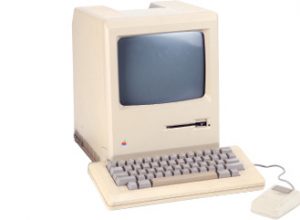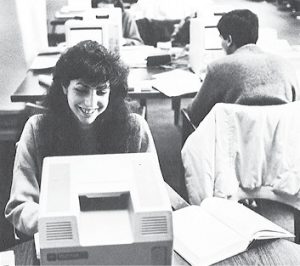
A vintage Mac.Computer Business Review
Thirty years ago, when Elizabeth Plowe Ross ’88 penned an essay for the Cornellian about the newfangled Macintosh computer, the boxy gizmos were on the cutting edge. “These computers are a godsend when you have to turn in a ten page paper in a matter of hours and have yet to think of an opening sentence,” the English major observed. “You can type as you compose and if you need to change anything, you may simply ‘cut,’ ‘insert,’ and ‘paste’ text without typing the whole essay over.”
CAM recently ran across Ross’s Mac essay in the 1988 yearbook while doing research for another piece; it seems charmingly quaint in 2018, when most of us carry far more computing power in our back pockets. We reached out to Ross—now a writer and artist in Nashville, Tennessee—to ask her to reminisce about it three decades later. But . . . “I actually don’t remember writing the piece,” she says with a laugh. “I do remember Macs on campus. I remember it was frustrating when you had a paper due, to find a printer that wouldn’t jam.” After rereading it, she says, “It’s funny to see how new they were. Now, they’re such a part of our lives that we’d be lost without them.”

Helen Skolnick ’89 in Uris.Ken Zirkel ’88
Accompanying the essay—which Ross had been assigned as part of her work on the yearbook staff—was a photo of a young woman using a Mac in Uris Library. The model: chemical engineering major Helen Skolnick ’89. Although the photo comes across as an action shot, Skolnick was actually posing at the behest of a photographer friend, Ken Zirkel ’88. Now a pediatric allergist in New Jersey, she recalls using Macs on campus for her engineering design projects. “It was really hard to get on a computer,” she remembers, “because there weren’t that many.” And while they were generally dependable, she says, “every once in a while you’d get the little bomb on the screen and it would be like, ‘Nooo!’ ” Both alums report that while they’ve used PCs at times over the years, their computing preferences haven’t changed since their student days. “I have a Macbook Pro at home,” says Ross. “I’m an Apple person all the way.”
Life on a Mac
No matter what area of campus you happen to be on when you get a “Mac” attack, you will almost always be able to satisfy your “craving.” Macintosh computers can be found anywhere from Uris Library and Goldwin Smith Hall to Upson Hall and Riley Robb. You will even find three Macs tucked away in the basement of McGraw Hall, and North Campus residents will stumble upon them downstairs at Entrepot.
Of course there is no perfect computer center. Finding a working printer in Uris Library is rare, most of the Macs in McFaddin do not work, playing musical chairs in Martha Van Rensselaer as you are bumped and reassigned a new machine every hour grows tiresome, and the computer room in Goldwin Smith is at least 20 degrees too warm.
Macintosh computers, however, are essential tools to everyone from English majors to electrical engineers. And though just about every student meets some difficulty trying to find a Mac, he does inevitably find one. This is largely due to the University’s realizing the Mac’s importance, and providing more computing facilities than can be found at most any other school.
These computers are a godsend when you have to turn in a ten page paper in a matter of hours and have yet to think of an opening sentence. You can type as you compose and if you need to change anything, you may simply “cut,” “insert,” and “paste” text without typing the whole essay over.
Some Mac programs even include spelling checkers, an indispensable tool at 3:00 in the morning when you don’t have much of a brain left to figure out if “receive” is spelled “i-e” or “e-i.”
Being able to increase the size of the type throughout the document also comes in handy when you find out your ten page paper is only eight pages long.
It pays to establish a good relationship with the user-friendly Macintosh, and with the work load here you’ll probably find you spend just as much time talking with Mac as you do with your other friends.
— Elizabeth Plowe



I brought a heavy Adler manual typewriter to Cornell in the fall of 1983. It was a great, if clunky, workhorse and required gallons of white-out to turn in anything respectable. I remember writing my first “Mac paper” – about 15 pages – where I discovered the miracle of integrated footnotes. It took 2 floppy disks to store my masterpiece. The Adler wasn’t retired until I was graduated and, despite my Mac-inspired confidence in word-processing, was more than a little deflated when I was confronted with a PC at my first job and had to learn a completely different operating system.
Haha we recently had a get together of six class of ’86 friends where we read our old letters to each other out loud. They started as handwritten. Around 1985 we exclaimed in the letters that we were typing on a word processor and it was so amazing. What a laugh we had that night. Moira Dolan’ 86
Ah, the memories! I worked for CIT (originally CCS, for Cornell Computer Services) starting the second semester of my sophomore year, which would have been 1987. That semester, I was a PTOP (Part Time OPerator) in the computer room in Warren Hall, and the following summer, I worked as an FTOP (Full Time OPerator) in Sibley Hall’s computer room. For the next two years, I was a STOS (Student Terminal Operations Supervisor) in charge of the PTOPs in a variety of different computer rooms. My then-girlfriend, now-wife Tonya (Byard) Engst was also a STOS our senior year, and she was in charge of the staffing for the Uris Library computer room shown in the picture.
Not all the computer rooms on campus were run by CIT, though, so when the writer was commenting about how the Macs in McFaddin didn’t work, I believe that’s because they weren’t a CIT installation. The PTOPs generally did a very good job of keeping ImageWriter and LaserWriters working in the CIT rooms, to the extent possible.
I could write a book full of the stories of early computing from those days, such as when Cornell was ground zero for early Internet worms and viruses, battling with students who were intent on hacking the VendaCards used to pay for laser printing, the time a student figured out how to change the PostScript password in a LaserWriter (which would have required a multi-thousand-dollar repair if a friend hadn’t tipped us off about what the new password was), moving Macs around in the basement of Carpenter Hall so the pipes wouldn’t leak into them, helping a grad student convert her dissertation from MultiMate to WordPerfect over an entire summer and getting a bottle of wine as a thank you, and more. It would be fun to write, though the audience would be pretty small.
Part of the reason all this has remained somewhat fresh is that working in the Cornell computer rooms informed the rest of my career. I did Mac consulting briefly after graduating, while Tonya continued to work for CIT, and then we started an online publication, TidBITS — https://tidbits.com/ — that covers the world of Apple technology to this day, over 28 years later. It has been a long strange trip, with Apple going from the perennial underdog to the most valuable company in the world.
I was there before the Macs arrived in the word processing room(Goldwin Smith Hall?), and when they came in to replace the IBM Displaywriters. My work/study job was to help students use the darn machines-“how do I paginate?” The IBMs looked like full fledged PCs, but were only word processors. I have a not so fond memory of a student losing her whole 100 page document on the IBM. Only a floppy back then-no backup on hard drive. Macs were much easier to use. Ah the fond memories….
That was 1983/84 folks.
The Macs came in the summer of 1984. I was working for Joe Martin tending to the Displaywriters during that summer when he lugged in the first Mac. Yes, people lost docs on those huge floppies, but sometimes we could save them. There were ways to get behind the menu driven interface. Wrote my Honors thesis in that GS room on Wednesday nights–I had a key, thanks–alongside Helen Knode, a grad student in the writing program, who later married James Ellroy. If Joe Martin is out there reading this, thanks for the job… and being the voice in my head whenever I write something that matters.
There is a nice picture of the first Mac lab on campus on page 124 of John Rudan’s, “The History of Computing at Cornell” (2004-01-29), available as a free PDF download from Cornell’s eCommons:
https://ecommons.cornell.edu/handle/1813/82
And I’m sure much fun could be had by going through the relevant archives in the Library’s Division of Rare and Manuscript Collections, for time periods of interest as indexed here:
http://rmc.library.cornell.edu/EAD/htmldocs/RMA03351.html
I was at Cornell when we needed permission and punch cards to use the mammoth computer at Rand Hall. By the time my daughter was a freshman the era of the personal computer was at hand. She had to deal with learning disabilities throughout her school career that made spelling a challenge. I worried that, once she got to Cornell in 1992, without parental proofreading she might have difficulty with unsympathetic professors bogged down by pages of misspellings. Her mother and I thought we had solved the problem by sending her off to Ithaca with a brand new Mac loaded up with Microsoft Word and its newfangled spell check software. But… “Dad! This computer is crap! The spell checker doesn’t work!” she cried over the phone as she struggled with her first English paper. After a bit of troubleshooting we figured out the problem — she had misspelled the same word 12 different ways.
I enjoyed reading the letters about the dawn of Macs and PCs at Cornell. I arrived in Ithaca early in 1964 to begin work for a Ph.D. in Microbiology. During the next 3.5 years I can’t remember seeing a computer at Cornell. Earlier at UCONN (B.A. ‘62, M.S.,’64) I had training in Fortran and had a good idea of what was required for programs on mainframe IBM computers. I used some very heavy-duty equipment during my Ph.D. research including a Siemens Electron Microscope and some expensive photographic gear but none of my work required a computer. The closest was a desk top electric adding machine. I also used a circular slide rule with slightly improved accuracy over the usual linear models. The lack of visibility also applied to word processors. My draft Ph.D. thesis was typed by my mother (God bless her) from my hand-written notes! I later (1968?) bought a portable electric typewriter which I modified with a small Greek mu symbol for micro which was frequently used in scientific work.
I didn’t own a hand calculator until 1971-2 (a Texas Instruments model). My first use of a computer in the work environment wasn’t until 1985, a MacIntosh. In 1988 I bought my first Mac, a SE20, which despite costing nearly $3500 with printer was DOA and had to be returned for logic board replacement. Of course, since that time I’ve had many Macs and PCs and currently have three MacBook Pros (2009, 2013, 2017) plus a Mac Mini with legacy software going back to 1989. Looking back, it’s surprising how slowly Macs and PCs penetrated, at least in my case.